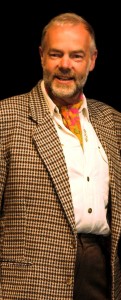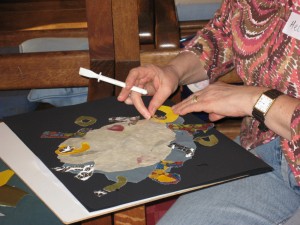by Jay Clark
Melvyn Freake is treasurer of the Art and Spirituality Network, a group of artists, writers and performers who run workshops that seek to explore faith and search for meaning through art. He talked to Nayler about his involvement with the network, and how he sees his Quaker spirituality influenced by creativity.
What workshops have you taken part in with the Art and Spirituality Network, can you explain a bit about them and your reactions to them?
Sometimes they have involved going as a group to a gallery or an exhibition for a half day, for example the Courtauld Gallery or the Hard Rain exhibition at St Martin-in-the-Fields in London. There we would meet as a small group and have a discussion, then tour the exhibition and find a work that has some resonance for us before using it as a springboard for a piece of work. Others are full day. I did one on Cecil Collins where we used a range of materials to draw a live model very quickly. Another involved working jointly with one person, or using the hand you don’t usually use, and finally making a piece of art as a group. More recently I did a workshop in a nature centre that had a small farm. The idea for me is to stimulate different areas of creativity, go on an exploration and not worry too much about the outcome.
What role does art play in your life, how has this changed over time?
I don’t think of myself as an artist in the sense of painting or drawing. But I think we can all use different ways of expressing ourselves. Quakers are encouraged to live adventurously. It is important to me to go to exhibitions, read novels and poetry, go to the theatre. This has included the visual arts to a greater degree more recently. Paying attention to a piece of art is paying attention to a part of me. It can provide depth, a different angle, beauty, challenge.
Producing art of various forms – drawing, painting, writing, and performing – takes me into a deeper dimension and understanding both of the work and myself. We’ve just finished playing part of Sophocles’ Oedipus – the scene where Oedipus asks Tiresius who killed the old King, Laius. Of course it is a classic work and has been looked at by many over the years. Performing it leads to a deeper interpretation because each little bit has to be experienced.
How does your appreciation of art influence your spirituality, and what have you learned about spirituality through creativity?
I’m a great believer in there being light from all sources and from wherever it may come. I’m also aware that experience allows me to see connections I didn’t appreciate before. My spirituality eats from many plates – life, silent worship, meditation, writing that claims to be spiritual. I think artists work best when they let go and allow the work to emerge, combining their technique with their own spiritual depths. At its best, when I approach a piece of art, I try to connect with those depths.
Which artists or writers particularly influence your spirituality, and why?
William Blake for his visions and boundary breaking. Jan Vermeer for the stillness and the complete story in a restful image. John Clare for his contact with nature and the struggle in himself. Mary Oliver and Robert Frost for their contact with the essential.
More recently I have been reading Hafiz. He says: “True Art makes the divine silence in the soul break into applause.†That I think is the connection with spirituality. It’s when art breaks the everyday mould and lets the light through. When I read Hafiz, Rumi and Tagore, I feel a mystical connection that makes my spirit soar.
You’re an amateur actor – what do you find fulfilling about performing?
It’s like other forms of art. Start with a blank stage; choose some material (a script) to work with; learn it and interpret it; design a set and build it; show it to an audience; savour the experience; pack it all away. There is a beginning, middle and end. I started acting as a challenge and means of fulfilment. I think I continued because my work as a social worker had so many loose ends and this was a complete contrast. Then, of course, I am also a bit of a show off….
You mention on your website that the art and spirituality network allows you to both play and go deeper into spirituality – can you say any more about that?
What is play? What is spirituality? In one sense the first is how we start our lives and the second how we end them. I guess I mean that art opens different doors to experience and perception – the more the better. When I let myself go in this different medium it has both fun and meaning.
Can you recommend any Quaker artists?
Woodbrooke [Quaker Study Centre in Birmingham] has had artists in residence in the past, including Adam Boulter and Caroline Jariwala. Judith Bromley Nichols has been a Rowntree fellow, with her art – concerned with the environment and inner landscape too. John Perkin and the late Ron Waddams have made lots of paintings of Meetings for Worship among other subjects. And then there’s the Appleseed work of Chris Cook and Brenda Heales, using art for prayer and spiritual exploration, and teaching this approach in their travelling ministry over the years and at Woodbrooke. Lots of Friends are now using art for their own spiritual exploration and facilitating workshops for others to do so – including through ASN (for anyone) as well as through Quaker organisations and in a variety of professional capacities. There is an email contact list for those interested in Quakers and the visual arts at noon_ukuk@yahoo.co.uk.
Then we have Judy Dench and Sheila Hancock on the stage and Philip Gross on the page. I also like to read Peter Daniels.
The Art and Spirituality Network can be reached at: http://www.artandspirituality.net.

